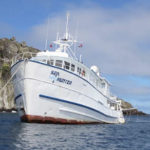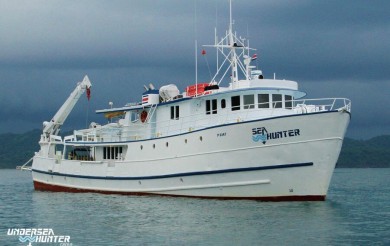Billfish: A Speed Junkie and a Master Swordsman
Billfish are composed of marlins, sailfish and swordfish which all have a bill-like protrusion in their upper jaw called rostrum. This large-sized fish are apex predators of the open ocean where they feed on a wide variety of fish, crustaceans and cephalopods. But what is really interesting with billfish is their behavioral resemblance to a car racer and a Samurai.
Fast and Aggressive
Billfish have large and elongated body with a highly developed muscular system that gives them the power to speed up in a chase for food or travel in long distances. Similar to tunas and mackerels, billfish are speed junkies where they are comfortable living their life in a fast pace rather than slowing things down. But billfish are faster than any tuna and mackerel species in the world. During a high speed chase, billfish can speed up to 80 miles per hour (130 kph), easily catching up with any fish, or any marine wildlife, earning them the fastest swimming fish in the world.
Having the ability to speed things up, billfish have become aggressive to other species even it is bigger than its size. While considered as an apex predator, billfish has its own set of predators like sharks. But this does not mean that sharks can easily devour them without burning first their muscles in a high speed chase and a fight as billfish has an anatomical asset that is highly effective in defense and offense.
Humans and Fish: Beware of the Bill
While we now know that billfish has this protruding structure in front of their mouth, you might as well should know that they use it both as an offensive and defensive tool. When they are chasing their prey, they often sway their bills towards their target giving them a slashing wound. Although there are some reported incidence, billfish seldom use their bill as a spear. It’s function is similar to a knife where the flat, pointed and sharp properties of their bill easily slices the skin and meat of any fish.
In the case of a predatory attack, like sharks, they use the extent of their bill like a sword which usually measures one third of its body length. This attack may be costly to both of the lives of a billfish and a shark. Fisherman who go shark fishing said that they have seen broken bill embedded deep into the sharks body which is believed to be a remnant of an unsuccessful shark attack.
Billfish are highly attracted to floating objects and this is the case where human life is in danger. Underwater, you need to establish a safe distance in observing them. It is very seldom that divers are mistaken for food where they prefer to feast in schooling small fish like sardines. Still, you need to establish a safe distance because we never know when an accident will happen.
For sports fishermen who are using small boats, their are reports of billfish impaling their boats. The moment a fishermen hooks a billfish and tries to retrieve it back to the boat, billfish will become highly aggressive as it tries to break the line and setting itself free. This aggression can lead them directly towards the boat that may come charging at full speed and can possibly hurt any person onboard.
Species of Billfish in Cocos Island
Indo-Pacific Sailfish (Istiophorus platypterus)
Max. Length: 3.48 meters
Length at 1st Maturity: 1.15 meters
a value: 0.03990
b value: 2.570
Depth Range: 0 – 200 meters (0 – 600 feet)
Frequency: Abundant in the Indo-Pacific Ocean
Although they have a wide depth range, the Indo-Pacific Sailfish is one of the few fish species in Cocos island that prefer the shallow waters of the surface. In particular, you can find them above the thermocline zone which means that they prefer warm water than cold environments.
While one of the obvious identifying marks is their highly developed dorsal fins, you may wonder if it has something to do with their swimming motion allowing them to migrate in great distances around the globe where this anatomical feature can act as a sail. Well, while that function can be considered as a product of fictional creation, the true purpose of their sail fin has something to do with thermal regulation.
With the ability to produce speeds of up to 70 miles per hour (110 kph), their body temperature can easily overheat due to overexertion. By fully raising their sail fin, the blood vessel within supplies fresh oxygen that acts like a cooling system. You can particularly see a fully raised sail fin after a high-speed chase to its prey.
Striped Marlin (Kajikia audax)
Max. Length: 4.2 meters
Length at 1st Maturity: 1.25 meters
a value: 0.00020
b value: 2.501
Depth Range: 0 – 200 meters (0 – 600 feet)
Frequency: Near Threatened; found in the Indo-Pacific Ocean
The striped marlin is the most abundant billfish, not just in Cocos island, but in other major oceanic waters such as the Pacific ocean. Their frequency and abundance becomes higher as you further go out in the open sea. This is the reason why you seldom see a striped marlin during your underwater adventures in Cocos island. Except during your interaction with a baitball where this shallow water feeding frenzy usually occurs out in the open seas.
But just in case you encounter a striped marlin, you can easily identify them through its black-blue colored body with a dash of silver on the side and vertical stripes that is interspersed with rows of white spots. In other countries, fishermen prefer to fish out a striped marlin rather than other species of billfish since it commands a higher price as its meat is considered one of the best ingredient for sushi and sashimi. But, this is not the case here in Cocos island where all forms of fishing is prohibited.
Blue Marlin (Makaira nigricans)
Max. Length: 5 meters
Length at 1st Maturity: 1.80 meters
a value: 0.02570
b value: 2.760
Depth Range: 0 – 200 meters (0 – 600 feet)
Frequency: Near Threatened; found in the Atlantic and Pacific Ocean
The blue marlin is the biggest billfish you will see in Cocos island, but not in the world’s waters as swordfish holds the gold medal in terms of size and length. A blue marlin has a black-blue colored body with silvery white shadings on the belly and rows of pale black vertical bands that starts after the gills up to the tail.
Same with other species of billfish, blue marlins prefer deep-blue waters that has a crystal clear visibility. They use this ecological preference to easily spot their prey and start the chasing process where the fish that has the speed and agility wins a meal for the day.
Reference
Fishbase: www.fishbase.org
Encyclopedia of Life: www.eol.org
Wikipedia: www.wikipedia.org
Video courtesy from BlueWorldTV
You also might like these:
Cocos Island Liveaboard Trips for 2019
Due to high demand of liveaboard trips to Cocos island, as early as this year, we are publishing the 2019 trips for you to choose your preferred schedule and prepare for the ultimate diving adventure of your life. Reserve your seat to Cocos Island as they are selling like hotcakes. Schedule of Liveaboard Trip to […]





















